Navigation
Tap below for Sheriff’s Police Menu
Cook County Sheriff’s Police History
The Cook County Sheriff’s Police Department is the third largest police department in the State of Illinois. They are state certified law enforcement officers and are charged with patrolling unincorporated areas of Cook County as well as assisting suburban police departments with police operations including, but not limited to, detective and evidence services, narcotics interdiction, bomb detection and disposal, vice operations, street crimes suppression and hostage/barricade/terrorist incidents. Approximately 109,000 people live in unincorporated communities within Cook County among the county’s 5.3 million total population. The Cook County Sheriff’s Police Training Academy trains police recruits within the department as well as those from suburban agencies. The history of the Cook County Sheriff’s Police Department can be traced back to May of 1831 with the inauguration of Sheriff James Kinzie, the first Sheriff of Cook County. Cook County itself had only been incorporated four months earlier, on January 15th, 1831.
The Beginning, Patrol Increases as Suburbs Grow. The Creation of The Cook County Highway Police Department
In the early 1900s as the City of Chicago grew, so did the rural areas that surround it. Highways were created to connect the suburban towns that began dotting the Cook County landscape and traffic increased. Some larger communities like Evanston and Cicero funded their own police departments, but criminals knew they could usually escape their dastardly deeds by simply crossing municipal boundaries.
November 25, 1921 – Sheriff Charles W. Peters proposes the Sheriff’s Office create a police force dedicated to patrolling the roadways and areas of suburban Cook County. Sheriff Peters requests to hire one-hundred and twenty-five (125) officers. Police enforcement in the suburbs had evolved from the turn of the century and had been carried out by several Cook County governmental agencies that contributed random employees who patrolled the highway areas of the suburbs. The new proposal for a formally organized department met with much resistance from several elected officials who feared the Cook County Sheriff would have too much control over the employees assigned to this detail. A Chicago Tribune editorial at the time supported the creation of the Department, writing “an efficient highway police system will safeguard … the lives and property of automobile owners and others on the highways.”
January 6, 1922 – At the request of Sheriff Charles Peters, The Cook County Circuit Court approves seventy (70) new Highway Policemen, mounted on motorcycles patrol county roads. Each man was to supply his own motorcycle and would be paid one-hundred twenty-five dollars ($125) a month and would be allowed a certain amount for the upkeep of his machine.
February 25, 1922 – The Cook County Board approves the creation of the Police Department. The Board approves one chief highway deputy, three sergeants and seventy motorcycle men, working three shifts. They began with three districts.
April 1, 1922 – On April 1, 1922, the first 32 Cook County Highway Police Officers were officially] sworn in for duty. The majority of those first officers had military backgrounds, including the Department’s first Chief Deputy Highway Sheriff Albert Denman, who had served as an artillery major overseas.
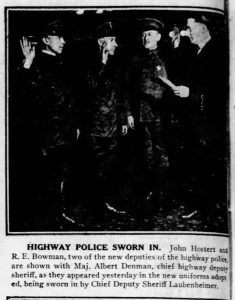
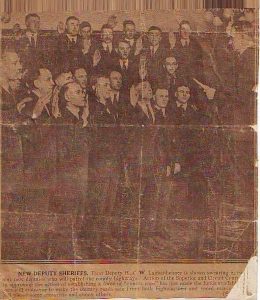
The new officers were required to wear khaki uniforms – similar to regulation Army uniforms – with leather puttees, or calf covers, most likely to protect their legs, as all of the new officers patrolled on motorcycles. News reports at the time noted each officer was to supply their own motorcycle and would be paid $125 per month by the county, with a certain amount given for the upkeep of the vehicle.
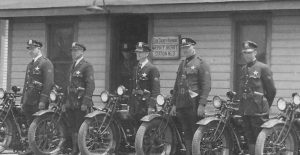
To meet the needs of the new officers, several stations were strategically located and opened throughout Cook County. The first station, known as Station 1, opened at Waukegan and Dempster in the northern part of the county, until a new building was completed in 1924 at 8970 N. Milwaukee Ave, Maine Township. Additional locations were also initially planned for an area near 147th and Western Avenue and one in the vicinity of Palos Park.
Patrols began with three shifts of eight hours each and a temporary headquarters for the new police department was set up in the Cook County Building, Room 1123 ½.
October 15, 1922 – Officers Robert Mann Stafford and Henry C. Westlund become the first Cook County Highway Police Officers killed in the line of duty.
Police Officer Robert Stafford and Police Officer Henry Westlund both succumbed to injuries when their police motorcycles collided on River Road, between Higgins Road and Des Plaines, IL. Officer Stafford was transported to Montrose Hospital, where he died the following day. Officer Westlund was transported to Iroquois Hospital where he succumbed to his injuries on October 24th, 1922.
July 22, 1923 – Cook County Highway Patrolman Claude Bowman was killed when he was thrown from his motorcycle after colliding with another vehicle that turned into his path as he was chasing a speeding vehicle in Bartlett, Illinois. Officer Bowman died at the scene.
1924 – Cook County Highway Police Station #1 at 8970 N. Milwaukee Avenue opens in unincorporated Maine Township. The building had a Morton Grove, Illinois mailing address and telephone number. Construction of this building was begun in 1923 and finished in 1924. A temporary facility at Dempster & Waukegan was utilized while this station was being built. This photo was taken to memorialize Policeman Harold Kegler, star #1223, who was killed in a line-of-duty in a motorcycle accident in 1925. This building was used by CCSPD until 1984 when it was leased to the Niles Historical Society for ninety-nine (99) years.

May 29, 1924 – Cook County Police Station #19 is opened at Archer and Kean Avenues in Justice, Illinois. The building is a one-story building owned by the Cook County Forest Preserve District. Eighteen Officers are assigned to the station. The telephone number is “Willow Springs 9”. The building was formerly a bowling alley.
June 7, 1925 – Policeman Harold Kegler #1223 was killed in a motorcycle accident while attempting to stop a speeding vehicle on Milwaukee Road in Maine Township.
As Policeman Kegler was entering the police station, he observed a car speed past its entrance. He immediately jumped onto his motorcycle and attempted to stop it but was thrown from his motorcycle near Milwaukee and Ballard when it struck a piece of timber that was in the roadway. Policeman Kegler was taken to St. Francis Hospital in Evanston where he succumbed to his injuries the following day.
June 24, 1928 – Policeman John Sweitz was killed in a motorcycle accident as he and his partner patrolled River Road in Norwood Park Township.
As they attempted to catch up to a speeding car another vehicle crossed into his path at Bryn Mawr Avenue. His motorcycle collided with the vehicle, and he was thrown into a ditch. He suffered fatal injuries and died at the scene.
April 20, 1930 – Policeman Sam Kaiser succumbed to injuries suffered two days earlier when his motorcycle struck a utility pole on Archer Avenue, near 79th Street, while he was attempting to stop a speeding vehicle. He was taken to Little Company of Mary Hospital where he remained until succumbing to his injuries.
May 24, 1930 – Policeman Frederick Bryant was killed when his motorcycle struck a ditch while he and his partner attempted to stop a speeding vehicle. The accident occurred on Higgins Road near River Road in Maine Township. He was taken to Westlake Hospital where he succumbed to his injuries.
August 24, 1931 – Policeman Robert “Red” McCarthy was killed in a motorcycle accident at the intersection of Graceland Avenue and Rand Road in Des Plaines, Illinois at approximately 2:00 am. Officer McCarthy and another officer were on patrol when a vehicle turned left in front of them, causing a collision. Officer McCarthy succumbed to his injuries while being transported to Des Plaines Emergency Hospital. The driver of the car that caused the collision was arrested and charged with manslaughter.
September 5, 1931 – Policeman Joseph Meyer Lapine was killed in an automobile accident at the intersection of Rand and Wolf in Des Plaines, Illinois while he was attempting to stop a speeding vehicle. The collision occurred when another vehicle turned into the officer’s path at the intersection. Officer Lapine had served with the Cook County Highway Police for eight years and was assigned to the Morton Grove station.
January 20, 1933 – Justices of Circuit Court of Cook County announce their decision that the Cook County Highway Police will be abolished on May 01, 1933. The Justices recommend a metropolitan state police force be created to replace the current police force. Sheriff William D. Meyering objects to the decision and fights the matter in the Circuit Court. The Cook County Board will not have to include the Highway Police in it’s current budget as a result of the ruling.
February 22, 1933 – The Cook County Board after hearing testimony from Sheriff William D. Meyering agrees to continue the Cook County Highway Police Department until July 01, 1933. The Board states that they had not appropriated money for the police force in the 1933 budget.
May 24, 1933 – A decision is made by the Cook County Board to continue the Cook County Highway Police. The decision was made after Judge Phillip J. Finnegan, Chief justice of the Circuit court announced his original order was rescinded after the Illinois Legislature failed to make an expected provision for a metropolitan police force.
July 05, 1933 – Sheriff Meyering files legal action against the Cook County Board after they failed to appropriate salaries of police officers after July 01, 1933.
August 11, 1934 – Policeman Robert Schanbaum #1302 was struck and killed by a drunken driver while he and his partner issued a speeding ticket to another driver on Milwaukee Avenue. The occupants of the car, a family of four, and the two officers were standing next to the vehicles discussing the ticket when another car approached and struck the group. Officer Schanbaum and the driver being ticketed were killed. The driver’s wife and two children were injured, along with the drunken driver who was ejected from his vehicle. Officer Schanbaum’s partner was not injured. Officer Schanbaum had served with the Cook County Highway Police for seven years.
July 1, 1935 – Sheriff John Toman, unhappy with ambulance service provided by private ambulance companies convinces the American Red Cross to train all Cook County Sheriff’s Highway Police Officers in First Aid. Sheriff Toman equips several vehicles with stretchers and space to transport injured persons to nearby hospitals. On July 01, 1935, Sheriff Toman released a public service video announcing and demonstrating the service now available from the Cook County Sheriff’s Highway Police.
August 23, 1936 – Highway Police Chief Lester J. Laird, Traffic Court Judge John Gutknecht and Don Hancock of WBBM Radio board an airplane and transmit traffic congestion over the radio. Chief Laird would later be credited with starting air traffic reporting.
March 19, 1937 – Sheriff John Toman officially opens the new Cook County Sheriff’s Highway Police Station located on Ridge Road near Halsted in Homewood, Illinois. The new building contains a courtroom, cells, shooting range and an officer’s quarters. This building replaced a shack at 175th and Dixie Highway used district headquarters.
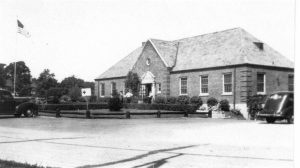
January 18, 1938 – Sheriff John Toman officially opens the new Cook County Sheriff’s Highway Police Station located at 67th Street and Archer Avenue in Argo, Illinois (now Bedford Park). The property itself was donated to Cook County by Argo Corn Products. Argo Corn Products wanted an immediate police presence and was located across the street from the station. This station would replace the station at Archer and Kean, a former bowling alley, heated with a wood stove. This station still stands and is now used by the Bedford Park Police Department.
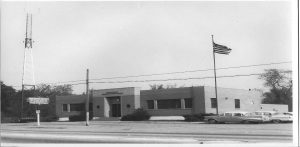
January 24, 1939 – At the request of Highway Police Chief Lester Laird, The Circuit Court of Cook County approves increasing the Cook County Sheriff’s Highway Police from one hundred (100) officers to one-hundred twenty-five (125). Chief Laird successfully argued that since created in 1922 the Suburban population of Cook County had doubled from 400,000 to 800,000.
1940 Census – The Cook County population living within the City of Chicago had dropped to 83 percent from its high of 90 percent in 1889.
October 19, 1941 – Policeman Frank Christian was struck and killed by a drunken driver at the intersection of Harlem Avenue and 79th Street, in Stickney Township while he was investigating a previous accident. Officer Christian and his partner had placed flares to warn approaching traffic of the accident. As Officer Christian was directing traffic using a red flashlight, he was struck by a vehicle and thrown 50 feet. The driver of the vehicle was arrested and charged with manslaughter after admitting to having consumed 20 to 25 beers prior to the accident. Officer Christian had served with the Cook County Highway Police for three years.
November 30, 1941 – Sheriff Thomas J. O’Brien shares the Cook County Sheriff’s Highway Police radio frequency with fifty-five (55) Police Departments creating an emergency radio network that allows agencies to exchange live information. All agency radios were given access to radio towers at Area 1 (Niles), Area 2 (Homewood) and District 6 (Argo).
June 6, 1945 – Policeman William Pottow #702 and Policeman Leonard Hurwitz #584 were killed in an automobile accident at the intersection of Touhy Avenue and Harlem Avenue, in Niles, Illinois. The Officers were attempting to stop a car for speeding on Touhy Avenue when their patrol car was struck by a third car. Officer Pottow died at the scene while Officer Hurwitz succumbed to his injuries three days later.
June 26, 1947 – Sheriff Elmer Walsh, after receiving an ambulance donated by the Veterans of Foreign Wars (V.F.W) announces that he intends to purchase additional ambulances in the 1948 budget. At the time the Cook County Highway Police Department is responsible for over one-thousand square miles of unincorporated Cook County.
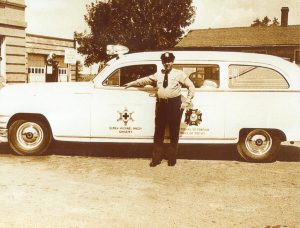
December 10, 1953 – Sheriff John Babb proposes consolidation of all police units of Cook County into a Metropolitan police force. Sheriff Babb states that there are currently 101 police departments in Cook County that are “inflexible for efficient work”. Sheriff Babb compares his current police department of 125 men to the Los Angeles Sheriff’s Office that patrols the same amount of area with 1500 officers.
July 15, 1957 – Police Officers from the Cook County Sheriff’s Highway Police, a squad of journalists, and three U.S. Marine sergeants arrived at the banks of the Chicago Sanitary and Ship Canal near Route 83, northeast of Lemont Township. The Marines were veterans of the Korean War, including one of nine survivors of a 32-man combat team. Under the watch of Sheriff Joseph D. Lohman, the Marines used flamethrowers to torch a field of marijuana, some of which was growing over eight feet tall.
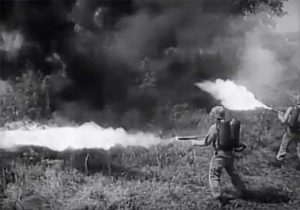
January 30, 1959 – Sheriff Frank Sain, unhappy with private ambulance services announces the purchase of three (3) ambulances for use by the Cook County Sheriff’s Police Department. All officers will be trained in first aid. The service will be provided without charge. The vehicles will perform a dual purpose of ambulance and patrol vehicle. The vehicles will be assigned to Area 1 (Niles), Area 2 (Homewood) and District 6 (Argo).
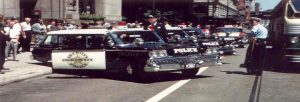
March 23, 1959 – Sheriff Frank Sain promotes Edward T. Vasser to the rank of Captain. Captain Vasser will be the first African American Captain with the Cook County Sheriff’s Police Department.
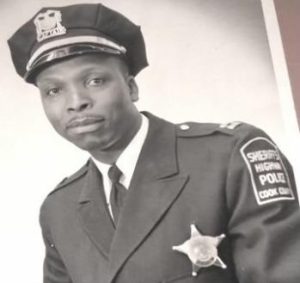
October 21, 1959 – Sheriff Sain is granted permission from the Circuit Court to hire an additional 100 officers for the Sheriff’s Police. Sheriff Sain testified that several suburban communities rely on the Sheriff’s Police for police protection as a whole. Judge Tuohy, in his ruling cited that “For the most part, these communities which are large enough to incorporate and form their own governments and police departments, but which have been avoided doing so for the selfish reason of keeping their local tax rates down.”
July 15, 1960 – Sheriff Frank Sain announces the purchase of three (3) tow trucks for use by the Cook County Sheriff’s Police Department on traffic crashes. The service will be provided without charge like the ambulance service that began in 1959. The vehicles will be assigned to Area 1 (Niles), Area 2 (Homewood) and District 6 (Argo).
January 30, 1961 – Sheriff Sain is served with a demand from Teamsters Local 726 that union drivers should operate the tow trucks purchased in 1960. The vehicles are currently operated by Highway Deputies. Sheriff Sain argues that a Highway Deputy makes $4,824.00 annually and a Teamster makes in excess of $6,000.00 annually. Sheriff Sain argues that Deputies would perform police duties when not operating tow trucks where Teamsters will spend most of their time “Dozing or playing gin rummy in the station while they wait for a tow.” Sheriff Sain refers the matter to Cook County Board President Daniel Ryan. President Ryan instructs Sheriff Sain to drop the free towing plan and turn the tow vehicles over to the Cook County Highway Department. Sheriff Sain defies the demand and continues the program staffed with Highway Deputies.
May 10, 1961 – Sheriff Sain prepares a mutual agreement between several communities surrounding O’Hare airport. His disaster plan would be activated should an airline disaster exist at O’Hare or surrounding area.
The Sheriff’s Police Department under Sheriff Richard B. Ogilvie.
December 3, 1962 – Richard Ogilvie was inaugurated as the 46th Sheriff of Cook County. As part of his campaign platform, he had promised a complete reorganization of the police patrol function within the Cook County Sheriff’s Office. Sheriff Ogilvie moved forward with his plan, creating a Merit Board to test police applicants and review applicant credentials for police officer positions. The name “Cook County Sheriff’s Police Department” was adopted. The traditional Sheriff’s colors, tan and brown, were used for the new Sheriff’s Police uniform.
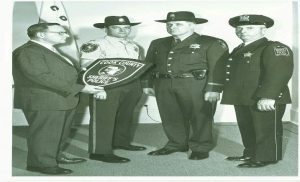
Sheriff Ogilvie successfully petitioned the Illinois Legislature to enact laws permanently establishing the Merit Board and a separate Sheriff’s Police Department in every county with a population over 1 million (now Illinois Counties Code, 55 ILCS 3/8).
The goal of Sheriff’s Ogilvie’s newly reorganized Sheriff’s Police was to provide high quality, professional police service to the citizens of Cook County. During his four years as Sheriff many major accomplishments were achieved including:
September 02, 1963 – Officer Bernard Singer is assigned to conduct air traffic reports for WGN in a Cessna Skyhawk airplane. The airplane can cover areas the WGN helicopter operated by the Chicago Police Department cannot cover.
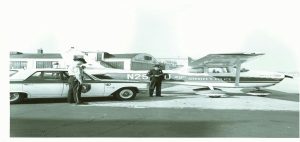
September 28, 1963 – Central Telephone System
A central telephone system is put into effect with the installation of a central switchboard for the Department at the Bedford Park facility. To obtain assistance in an emergency, a citizen can dial GLobe8-1000 (458-1000) from anywhere in the county. All calls are received by a central police radio dispatcher at the Bedford Park station who can then connect the caller with Division One in Niles or Division Two in Homewood, assuring the citizen of prompt and efficient attention to calls requiring police service. This phone number is still in use today.
June 25, 1966 – Helicopter Patrols
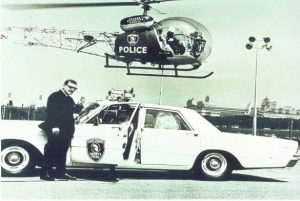
December 10, 1968 – Patrolman William Denear video records with audio a suspect he was interviewing in reference to a vehicle crash. The suspect is recorded conducting field sobriety tests and later charged with driving under the influence. This is the first-time video and audio recording have been allowed in a criminal or civil case in the State of Illinois.
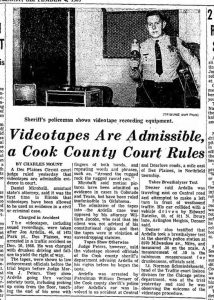
May 29, 1969 – Sheriff Joseph Woods announces The Cook County Sheriff’s Police has set up a Helicopter Emergency Ambulance System. The three helicopters were created to reduce accidental deaths and permanent disabilities due to motor vehicle accidents. “A soldier in Vietnam has a better chance for survival than a motorist seriously injured on a street or road in Cook County.” Several hospitals agree to install helicopter pads.
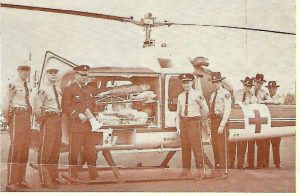
1970 – Richard Elrod becomes the first Sheriff to be elected Sheriff that can run for re-election. Prior to 1970 Sheriffs were only allowed to hold office for one term.
January 3, 1971 – Cook County Sheriff’s Police announce a helicopter equipped to act as a rescue transport for injured persons.
May 17, 1972 – Newspaper Chicago Today releases a report documenting that the Cook County Sheriff’s Police is responsible for providing police services to the largest area in Cook County, including the City of Chicago. CCSPD is responsible for providing police service to two-hundred and eighty (280) square miles of citizens in Cook County.
July 12, 1973 – CCSPD purchases the current headquarters in Maywood, Illinois. The new facility would be operational in January 1974. CCSPD Administration, Command staff, Records divisions and crime lab services will all be transferred to the Maywood facility.
January 16, 1975 – Sheriff Richard Elrod announced that CCSPD operations will be centralized and the facility in Maywood, Illinois will be the headquarters of patrol operations bureau. Area 1 (Niles) and Area 2 (Homewood) will remain open as headquarters for the detectives’ divisions.
August 3, 1977 – Investigator John Rusnak #152 was killed when his unmarked vehicle was struck from behind by a pickup truck while he was traveling southbound on the Tri-State Tollway in Alsip, Illinois. Investigator Rusnak was about to meet with other officers from his unit to do surveillance on a suspect’s home when his vehicle was struck. His vehicle was spun around and pinned against a guardrail. The pickup truck rolled several times after the initial impact, coming to rest on top of Investigator Rusnak’s vehicle before both vehicles burst into flames. Investigator Rusnak died due to the fire and massive internal injuries. Investigator Rusnak had served with the Cook County Sheriff’s Police Department for 11 years. He was survived by his wife Roberta, also a Police Officer with the department.
December 22, 1978 – John Wayne Gacy is arrested by the Des Plaines Police Department in reference to a missing juvenile investigation. CCSPD Evidence technicians, conducting a search warrant in reference to the missing juvenile discover evidence of possible human remains on the property located at 8213 W. Summerdale, Norwood Park Township. Additional searches by CCSPD result in the discovery of thirty-three (33) victims. Twenty-nine (29) victims were discovered buried on the property.
May 25, 1979 – American Airlines Flight 191 crashes during take-off from O’Hare International Airport in Chicago, Illinois. The plane crashed at 300 W. Touhy, Elk Grove Township. All 258 passengers and 13 crew on board were killed, along with two people on the ground. With 273 fatalities, it is the deadliest aviation accident to have occurred in the United States. The crash site would become the largest evidence recovery scene in Illinois history.
October 17, 1985 – Investigator Michael Ridges #380 was shot and killed after stopping three suspects who fitted the description of men committing vandalism to a local home in Prospect Heights. As Investigator Ridges was reviewing a series of vandalism incidents that occurred around a Prospect Heights home, he noticed a car with three men inside who closely matched the physical descriptions of the offenders in the case. Investigator Ridges called in a description of the vehicle and then stopped it. Once stopped, all three men exited the car and while Investigator Ridges was checking their identities, one man drew a concealed gun and shot Investigator Ridges once in the head and once in the hand,
fatally wounding him. The suspects were caught a short time later based on Investigator Ridges’ original radio description, along with a description provided by a citizen who witnessed the incident. It was later revealed through a police investigation that the three men were en route to commit a contract murder at the Prospect Heights home where Investigator Ridges was investigating the vandalism incidents. One of the suspects was sentenced to life in prison and a second was sentenced to 40 years in prison. Investigator Ridges had served with the Cook County Sheriff’s Police Department for five years.
Mid 1980’s – CCSPD Radio Communications transitions from sworn police officers to civilian dispatchers.
July 07, 1986 – Sheriff Richard Elrod appoints Samuel Nolan Chief of Police. Chief Nolan, a former First Deputy Superintendent of the Chicago Police Department is the first African American Chief of Police with the Cook County Sheriff’s Police Department.
February 06, 1988 – Sheriff James O’Grady, citing the flooding’s of 1986 & 1987 requests the Cook County Board add $548,298.00 in funding to his budget to create a full-time staffed Emergency Services and Disaster Agency within the Sheriff’s Department. Sheriff O’Grady stated that he currently has eight (8) employees working full-time Sheriff’s Office positions and completing emergency services responsibilities. This office, known as E.S.D.A. created by Sheriff O’Grady would become a full-time unit providing emergency services to citizens and communities of Cook County until 2007 when it was turned over to the Cook County President’s Office and renamed the Office of Cook County Homeland Security.
April 9, 1991 – Sheriff Michael F. Sheahan promotes Arthur Jackson to First Deputy Chief of Police. First Deputy Chief Jackson is the first person to hold this position in the history of the department. First Deputy Chief Jackson was promoted on April 9, 1991.

February 03, 1993 – Sheriff’s Police Patrol division officers begin working ten (10) hour shifts. The change in schedule allows for a common day where all officers are working allowing for training, targeted enforcement details and court duties. The new schedule also provides overlapping shifts during afternoon and evening hours providing more patrol units on the streets.
July 13, 1995 – Sheriff Michael F. Sheahan promotes Lieutenant Margaret Duffy to the rank of Captain. Captain Duffy is the first female Captain in the history of the department. Captain Duffy would later go on to be the first female promoted by Sheriff Sheehan to Commander and assigned as Commander of the North Area.
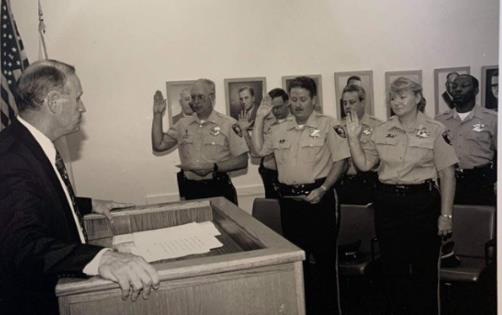
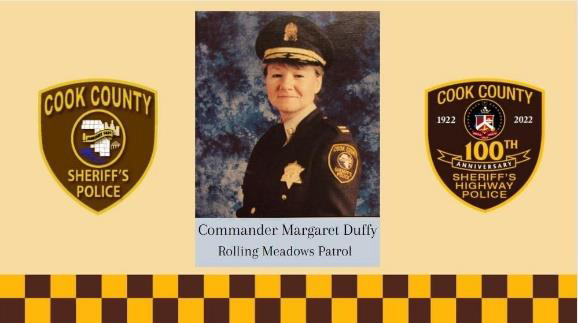
1996 – Construction begins on the new communications center in the Illinois State Police District Chicago Headquarters at 9511 Harrison St. Des Plaines, the former Maine North High School. Sharing the lower-level center with the ISP dispatchers.
October 10, 1996 – Several current and former Ford Heights police officers are indicted on federal racketeering, extortion, and narcotics charges. Left with only three (3) police officers the Cook County Sheriff’s Police and Illinois State Police aid the south suburban community. The Sheriff’s Police provided patrols, gang crime units and follow up investigations. The State Police provided response to traffic accidents. When it was determined that Ford Heights could not continue to fund a police department, Sheriff’s Police continued to provide all police services. To this day Sheriff’s Police Units are the primary police department for Ford Heights, Illinois.
March 13, 1997 – Communications moves into the new center in Des Plaines and takes the first 911 call for unincorporated Cook County.
November 13, 1997 – Cicero Illinois terminates several police officers creating a manpower shortage. Then Mayor Betty Lauren Maltese makes a request to Sheriff Sheehan for CCSPD to patrol the streets of Cicero until manpower can be restored. CCSPD provides uniform patrol officers and Gang Crime units for several weeks until relieved of responsibility by the Illinois State Police.
Fall of 1998 – The 911 center starts usage of their new CAD (computer aided dispatch) system and ceases pen and paper operations.
1999-2000 – 911 Center transitions from sworn Watch Commanders to civilian supervisors.
2000 – Sheriff Michael F. Sheahan promotes Officer Loyce Mason to the rank of Sergeant. Sergeant Mason is the first female African American Sergeant in the history of the department.
November 17, 2001 – At the direction of Sheriff Michael Sheahan, CCSPD receives accreditation from The Commission on Accreditation for Law Enforcement Agencies, (CALEA). CALEA was created in 1979 as a credentialing authority through the joint efforts of law enforcement’s major executive associations. CCSPD is the largest Sheriff’s Department in America to receive this accreditation.
January 4, 2006 – Officer James Knapp #408 was killed when he was involved in a motor vehicle accident at 6:15 am at the intersection of 100th Place and 76th Avenue in Bridgeview, Illinois. Officer Knapp was en route to the sheriff’s station in Bridgeview when his squad car rear-ended a semitrailer that was stopped waiting to make a left-hand turn during foggy and slick road conditions. He was extricated from his squad car before being transported to Advocate Christ Medical Center in Oak Lawn where he was pronounced dead. Officer Knapp had served with the Cook County Sheriff’s Police Department for 16 years. He was survived by his wife Grace, a lieutenant with the Cook County Sheriff’s Office.
April 10, 2008 – Sheriff Thomas Dart promotes Denise Roche-Evans Director of the Cook County Sheriff’s Police Communications Center (911 Center). Denise, a county employee since 1976 is the first Director of the 911 Center to rise through the ranks of the 911 Center beginning as a dispatcher.
April 12, 2009 – Sheriff Thomas Dart promotes Police Sergeant Gina Gray to Lieutenant. Lieutenant Gray #21 is the first female African American Lieutenant with the Cook County Sheriff’s Police Department.
2010 – Only 52 percent of Cook County’s 5.2 million residents lived in the City of Chicago.
2014 – Sheriff Thomas Dart promotes Police Officer Patricia Montgomery-Echols to the rank of Commander. Commander Montgomery-Echols is the first female African American Commander in the history of the department.

June 1, 2016 – The 911 Center consolidates with Metra Police to handle their dispatching and LEADS records. Metra marked the first of thirteen other consolidations to happen over the next five years. The Consolidated Communications Center currently dispatches for the following:
- Berkeley Police
- Blue Island Police
- Chicago Heights Police
- Cook County Forest Preserve Police
- Sheriff’s Office
- Sheriff’s Police
- Golf Police
- Harvey Police
- Hometown Police
- States Attorney’s Investigators
- Indian Head Park Police
- Lyons Police
- Merrionette Park Police
- Metra Police
- Palos Park Police
- Park Ridge Police
- Phoenix Police
- Prairie State College Police
September 15, 2016 – Police Officer Jason Gallero #684, assigned as an Instructor at the County Sheriff’s Police Department Training Academy suffered a fatal medical event while participating in a morning run at the Cook County Sheriff’s Police Training Academy in Maywood. Officer Gallero was running with cadets and other instructions participating in a memorial run dedicated to officers that have died in the line of duty when he collapsed near Fifth Avenue and Chicago Avenue in Maywood, Illinois. He was transported to Gottlieb Memorial Hospital where he was pronounced dead. Officer Gallero had served with the Cook County Sheriff’s Police Department for 14 years and had previously served with the Cook County Department of Corrections for 8 years.
September 2019 – The 911 Center takes on the responsibilities of the Fugitive Warrant’s Desk. Additionally, seven warrant clerks join the center’s staff, moving from the operation’s previous location at 937 Wood Street.
November 2021 – Sheriff Thomas Dart promotes First Deputy Chief Marlon Parks to the position of Undersheriff. Undersheriff Parks is the 1st African American to rise through all ranks of the Department to Become Undersheriff.
Today and the Future
In the hundred years since the Sheriff’s Police was made its own division within the Cook County Sheriff’s Office, each succeeding Sheriff has continued the original mission. The Department has been a leader in embracing new concepts in policing, such as the full-time evidence technician unit; the State-certified police training academy; gang and narcotics units; a full-time bomb disposal unit; and most recently, the creation of the Sheriff’s Office Intelligence Center.
The Sheriff’s Police is the third largest police department in the state, and within Cook County itself, is second only to the Chicago Police Department in the number of officers deployed every day.
In the years following Sheriff Ogilvie’s reorganization, the Sheriff’s Police Department has been regularly called to assist state, local, and federal law enforcement agencies. This was part of Sheriff Ogilvie’s vision to make the Sheriff’s Police a national leader, woven into the fabric of American law enforcement.
Each succeeding Sheriff, up to today’s Sheriff Thomas J. Dart, has done his part to ensure the proud tradition has continued.
The next 100 years will be defined by the same mission to provide quality, professional police service.
